“Spiky Lawn” by Bruno Maroni in Mishima City!
If you have the chance to visit Mishima City in the eastern part of Shizuoka Prefecture I would recommend you to visit the Clematis Gardens, the more for it that they offfer a free limousine service from and to Mishima JR Station!
The Gardens include a large museum showing the works of Bruno Maroni but his most remarkable creations are exhibited all year round in the very large park either on the luscious lawns or in front of other buildings!
What could a lone man do walking through pikes on a lawn?
The grass is integral part of the whole art work!
Is the man carefully walking in awe?
Or is he half containing his laugh?
Or has he found a new world beyond the grassy spike tunnel?
———————————-
“Infinity” by Bruno Maroni in Mishima City!
If you have the chance to visit Mishima City in the eastern part of Shizuoka Prefecture I would recommend you to visit the Clematis Gardens, the more for it that they offfer a free limousine service from and to Mishima JR Station!
The Gardens include a large museum showing the works of Bruno Maroni but his most remarkable creations are exhibited all year round in the very large park either on the luscious lawns or in front of other buildings!
looking too far ahead can turn you into stone!
Even so these eyes look a bit empty to me!
is infinity really beautiful?
————————-
“Man Looking Over The Wall” by Bruno Maroni in Mishima City!
If you have the chance to visit Mishima City in the eastern part of Shizuoka Prefecture I would recommend you to visit the Clematis Gardens, the more for it that they offfer a free limousine service from and to Mishima JR Station!
The Gardens include a large museum showing the works of Bruno Maroni but his most remarkable creations are exhibited all year round in the very large park either on the luscious lawns or in front of other buildings!
I had a good laugh at this particular statue as the Japanese are a very voyeuristic people!
And the laugh continued when looking at the man from the back!
Is he surprised, worried or perplexed?
———————————-
“Invisible Barrier” by Bruno Maroni in Mishima City!
If you have the chance to visit Mishima City in the eastern part of Shizuoka Prefecture I would recommend you to visit the Clematis Gardens, the more for it that they offfer a free limousine service from and to Mishima JR Station!
The Gardens include a large museum showing the works of Bruno Maroni but his most remarkable creations are exhibited all year round in the very large park either on the luscious lawns or in front of other buildings!
This statue is standing abutting a glass pane figuring the invisible barrier which had stopped the man!
Very important detail!
———————————
“Dismembered Man” by Bruno Maroni in Mishima City!
If you have the chance to visit Mishima City in the eastern part of Shizuoka Prefecture I would recommend you to visit the Clematis Gardens, the more for it that they offfer a free limousine service from and to Mishima JR Station!
The Gardens include a large museum showing the works of Bruno Maroni but his most remarkable creations are exhibited all year round in the very large park either on the luscious lawns or in front of other buildings!
It is when you look at this statue from other angles that you realize why I called it a “Dismembered Man”!
And from that angle it is difficult to realize what it represents!
—————————
“Flying Death” by Bruno Maroni in Mishima City!
If you have the chance to visit Mishima City in the eastern part of Shizuoka Prefecture I would recommend you to visit the Clematis Gardens, the more for it that they offfer a free limousine service from and to Mishima JR Station!
The Gardens include a large museum showing the works of Bruno Maroni but his most remarkable creations are exhibited all year round in the very large park either on the luscious lawns or in front of other buildings!
I called this particular statue “Flying Death”!
The fear of an approaching end!
Fast flying Death!
—————————-
“The Three Ages of Man” by Bruno Maroni in Mishima City!
If you have the chance to visit Mishima City in the eastern part of Shizuoka Prefecture I would recommend you to visit the Clematis Gardens, the more for it that they offfer a free limousine service from and to Mishima JR Station!
The Gardens include a large museum showing the works of Bruno Maroni but his most remarkable creations are exhibited all year round in the very large park either on the luscious lawns or in front of other buildings!
Back view.
I call this work “The Tree Ages of Man” although I heard that Bruno Maroni called it “Infinity”.
The Man himself seems apprehensive or sad?
He is apparently looking at his past…..
——————————–
Scarab by Bernard Buffet in Mishima City!
If you visit Mishima City in the Eastern part of Shizuoka Prefecture you ought to visit The Clematis Garden and the Bernard Buffet Museum in one single trip as they are very near each other.
You will be surprised at the amount of art on show!
It was brought to japan all the way to Mishima as it had been created in 1975 some time before Bernard Buffet came to establish himself in Mishima City!
You will see this enormous scarab statue by Bernard Buffet who also painted the same on a big canvas on show inside the Museum (no pictures allowed there unfortunately but definitely worth a grand visit!
In full flight through a rainbow?
A bit frightening through this angle, though!
————————–
Butterfly by Bernard Buffet in Mishima City!
If you visit Mishima City in the Eastern part of Shizuoka Prefecture you ought to visit The Clematis Garden and the Bernard Buffet Museum in one single trip as they are very near each other.
You will be surprised at the amount of art on show!
You will see this enormous butterfly statue by Bernard Buffet who also painted the same on a big canvas on show inside the Museum (no pictures allowed there unfortunately but definitely worth a grand visit!
As far as photography is concerned there loads of possibilities!
A side view will make it a hard guess!
Another possibility at an angle from the back!
Can you guess what the next picture of an insect statue might be?
————————–
Skiing Ants in Mishima City!
I’ve just come from a short trip and overnight stay in Mishima City and Izu Peninsula where I had the occasion to discover a few interesting sites!
I didn’t know that ants could ski, but now I ave the proof!
This one was pretty big standing/sliding on a high pedestal in a small park!
I even found a smaller one among the chrysanthemums!
Note that is is completely made of metal with a body formed by a frame around a stone!
This ant must be a lady ant!
The skis!
Stay tuned, more coming!
—————————–
Mishima City: Gate to Izu Peninsula
Gembei River
Mishima City is the located at the first important crossroads in Shizuoka Prefecture, whether you choose to follow westwards to Shizuoka City or veer southward into the heart of Izu Peninsula.
Mishima, as described in Hiroshige’s wood prints as the eleventh of fifty-three stops along Japan’s famous Tokaido Road, has welcomed travelers for centuries.
It is blessed with some of the purest water in Japan flowing down from Mount Fuji. One just needs to stroll along Gembei River or hop across it on flagstones to realize why the area has been a long-prized destination for famous and lay people alike.
Mishima Taishya Shinto Shrine
Mishima City’s most popular landmark is its shrine, Mishima Taishya. It first attracted attention when 800 years ago the future Shogun, Minamoto Yorimoto, prayed for his family’s return to power on his way back from exile in the Izu Peninsula. The shrine is located in the midst of beautifully-laid grounds including an area where visitors can feed domesticated deer.
But the best time to enjoy a visit of the shrine is when its 200 cherry trees, numbering some 15 different species are in full bloom between the end of February and the beginning of April.
The Mishima Festival takes place August 15th~17th every year in and around Msihima Tashya Shrine as well as near Mishima JR Station when Dashi/Parade floats and Mikoshi/portable shrines are rolled or carried through the streets and the Taiko/Japanese drums are played.
Other must-see spots include:
-Sano Museum celebrated for its collection of ancient swords and its great monthly exhibitions (Tel.: 055-975-7278).
-Yamanaka Castle Ruins Park where a castle used to during the Fighting Feudal Era. One can admire an exquisite vista on Suruga Bay and Mount Fuji from that very spot.
-Rakujyu Park designed in 1890 in the middle of a forest which had naturally over the lava left by Mount Fuji’s last eruption thanks to the constant flow of pure water from the nearby volcano. (tel.: 055-975-2570)
-Old Hakone Route, an ancient flagstone-paved road where one can experience a timeless walk amid centenarian cedar trees.
Recommended Visit Route:
Mishima City has conducted for a long time a project to improve the downtown area by using its historical and natural resources. The project’s title includes the word “seseragi”, which roughly means the sound of a burbling stream-a fitting choice for a city filled with rivers, ponds and natural springs. Forested parks and wide streets cover the city, but a particularly relaxing excursion is to walk along the Genbei River just south of the station. This winding path of moss-covered stones pokes above the gently flowing stream. The north end of the Promenade finishes behind The Japanese Park Rakujuen, which includes a zoo, amusement park, and a variety of Japanese gardens throughout its sixteen-plus acres.
Mishima Unagi!
After exploring Mishima City, hungry visitors are sure to come across some of the area’s distinctive culinary specialties. Connoisseurs often travel to this city to sample the local eel, called “unagi” in Japanese. Before being cooked, the eels are left to sit tubs of clear spring water that flows from nearby Mount Fuji to remove compounds in the eel’s skin and to cause the fish to burn off excess fat. “Unagi-don”, which features eel broiled with a sweet, rich sauce and served over a bowl of rice, is the most famous dish in town. In 2008, the Association of Eel Restaurants in Mishima have taken the remarkable step to use only domestically-bred eels to preserve natural stocks and prevent rampant illegal import!
ACCESS:
About 50 minutes by Shinkasen Bullet Train from Shinagawa JR Station (JR Tokaido Line)
*FROM NARITA AIRPORT (International Airport):
About 2-2.5 hours from NARITA-Airport to Mishima (pronounced MI-SHI-MA) (The JR “NARITA Express” train from NARITA to TOKYO & JR Super Express “HIKARI or KODAMA” from TOKYO to MISHIMA).
*FROM HANEDA AIRPORT (Domestic Airport, a transit from KANSAI International Airport):
About 1.5 hours (A KEI-KYU train from HANEDA airport to SHINAGAWA & JR Super Express “HIKARI or KODAMA” from SHINAGAWA to MISHIMA)
——————————-
Japanese Festivals: Mishima Taisha/三嶋大社
There are many interesting festivals in Shizuoka Prefecture and it is great fun as they offer a glimpse on true traditional Japan as well on a culture that will never fade away whatever the times.
Mishima Taisha Matsuri/三嶋退社祭/Mishima Shinto Temple Festival takes place during the third week of August (15th~17th this year) to coincide with the O-Bon Festival.
So I took a fast train this morning from Shizuoka City and got off at Mishima JR Station to enjoy the sights.
Follow, if you please!
True to say, as soon as I came out of the station, a parade had just entered the same street!
At 11:30 a.m. it was already blistering hot (over 30 degrees Celsius!) but the kids kept fanning the participants!
Tough work to pull that chariot along!
And playing music on top of it was even hotter!
I’m sure they could done better with the water of that well (a pun?)!
Volunteers at crossroads made sure everyone went the right way!
Mishima City is celebrated all over Japan for its eel restaurants dotting the streets!
Another one!
Another well for thirsty people!
The streets were lined with “yatai/屋台/stands well before the entrance to the Shrine!
These cold drinks should sell quickly!
Sakurabou/long pink light bread!
Shaved ice!
The torii/鳥居/gates for the birds. Such gates are the entrances of Shinto Shrines, never at those of Budhist Temples.
We know we are there!
Sake keg from Hana no Mai Brewery in Hamamatsu City. Unfortunately there is no longer any sake brewery in Mishima City!
More stands inside the premises before the actual entrance to the Shrine. Fujinomiya City-style Yakisoba!
Yakitori!
The Park is worth visiting at any time of the year!
Goldfish catching!
A photographer’s paradise (a pun again?)?
The real entrance to a Shinto Shrine is marked with a “giant straw belt”!
A young girl going bananas? We haven’t passed through the entrance yet!
Fukutarou “Happiness” buns!
A secondary entrance through the wall surrounding the Shrine. The blazing sun was starting interfering with the photography!
Clean water is available to wash your hands before the entrance of any Shinto Shrine!
Next year is the Year of the Horse!
If the chrysanthemum of the “mon/seal” has 16 petals, the Shrine is part of the Japanese Emperor’s Cult!
What’s happening there? We’ll check later!
It is always worth it to nose around a large Shinto Shrine: Ikebana/生け花/Flowerarrangement!
Hidden gardens…
Portable fireworks!
Back to that event!
But let’s go around it first! What a blazing sun!
Impressive roofs!
Imperial “mon”!
This roof really looks like a helmet!
Your future for 200 yen (2.20 US$)!
The ladies selling at a Shrine stand/shop are supposed to be virgins…
Look at her headgear!
Knotting one’s wishes for the coming year…
Now, why are these three gentlemen dressed in Edo Era’s garb?
Those ancient clothes are certainly very elaborate!
I see! A (very solemn) tea ceremony!
The ancient shoes of the three gentlemen! Like their clothes, they must cost a fortune!
An illustrious unknown?
I walked across the other side of the gardens surrounding the Shrine on my way back to discover more stands. Japanese karaage/deep-fried chicken! Certainly better than those of that fake army officer!
Charcoal-grilled ayu trouts!
Cute young girls in yukata/summer kimono waiting for their yakisoba!
Such trees at Shinto Shrines are venerated as symbols of virility and fertility!
Now, I fancy these yakitori!
There are plenty of secondary shrines on the premises near waterways and small bridges!
There was another parade chariot at the side entrance with some good percussion music!
But the old guy was already probably thinking about all the Japanese sake sitting beside him!
Now, getting this chariot was sheer brutal work in that heat! It took them three tries before they could manage inching forward!
Walking around the park back to the station is also worth the effort!
Beautiful water running down from nearby Mount Fuji!
The wild ducks certainly love it!
A small bridge turned into a personal garden!
Plenty of clean water to safely play in!
Young ladies certainly welcomed the fresh water!
Whole families were thus escaping from the heat!
i could have stayed hours in such surroundings!
In Japan, always keep a look for English signs!
I know that the Japanese are probably the longest living people in the World but I still wonder…
Back at the station, all these lanterns announced the Festival. Pity I couldn’t stay still night!
There was even an on-going Japanese drum concert by a whole host of teams!


























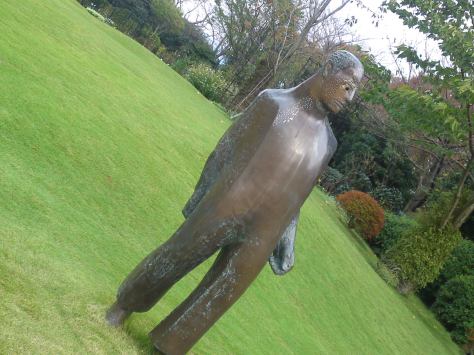









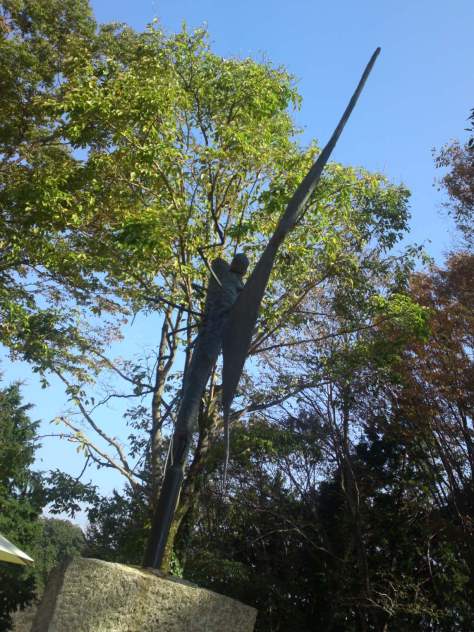

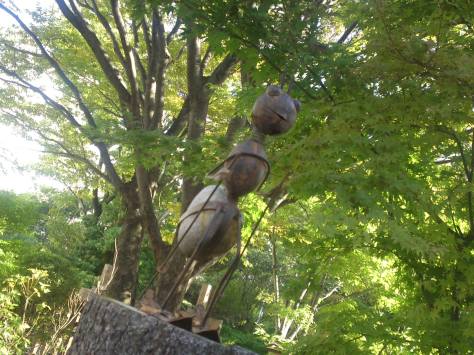






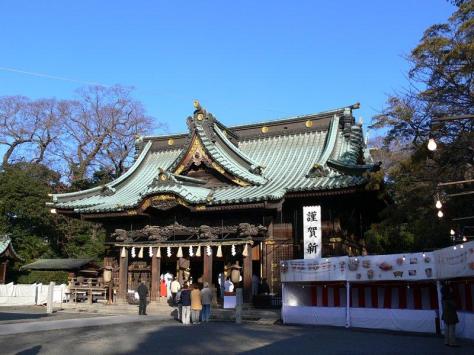
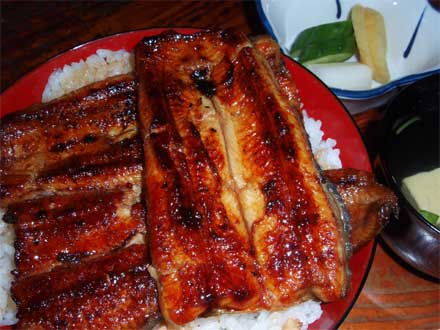



































































Don, here…
I couldn’t find this continuation….did it get “lost in translation” or is it waiting for a “round toit?”… 🙂
Part one was great!
That is all for the moment!